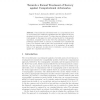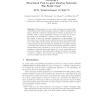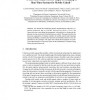92
Voted
GC
2004
Springer
15 years 4 months ago
2004
Springer
This article summarises part of the work done during the first two years of the SOCS project, with respect to the task of modelling interaction amongst CL-based agents. It describe...
98
Voted
GC
2004
Springer
15 years 6 months ago
2004
Springer
Polynomial time adversaries based on a computational view of cryptography have additional capabilities that the classical Dolev-Yao adversary model does not include. To relate thes...
122
click to vote
GC
2004
Springer
15 years 6 months ago
2004
Springer
In this paper, we consider semantic service discovery in a global computing environment. We propose creating a dynamic overlay network by grouping together semantically related ser...
GC
2004
Springer
15 years 6 months ago
2004
Springer
90
Voted
GC
2004
Springer
15 years 6 months ago
2004
Springer
In this paper an extension of a behavioural subset of UML statecharts for mobile computations is proposed. We study collections of UML objects whose behaviour is given by statechar...
90
Voted
GC
2004
Springer
15 years 6 months ago
2004
Springer
The DEGAS project aims at enriching standard UML-centred development environments in such a way that the developers of global applications can exploit automated formal analyses wit...
104
click to vote
GC
2004
Springer
15 years 6 months ago
2004
Springer
This paper presents a locality-based dissemination graph algorithm for scalable reliable broadcast. Our algorithm scales in terms of both network and memory usage. Processes only h...
92
Voted
GC
2004
Springer
15 years 6 months ago
2004
Springer
Abstract. We present the computational counterpart of the KGP (Knowledge, Goals, Plan) declarative model of agency for Global Computing. In this context, a computational entity is ...
GC
2004
Springer
15 years 6 months ago
2004
Springer
Abstract. Structured peer-to-peer overlay networks are a class of algorithms that provide efficient message routing for distributed applications using a sparsely connected communic...
104
click to vote
GC
2004
Springer
15 years 6 months ago
2004
Springer
We describe the architecture and the implementation of the MIKADO software framework, that we call IMC (Implementing Mobile Calculi). The framework aims at providing the programmer...



